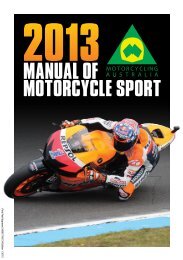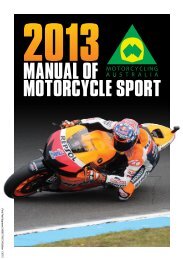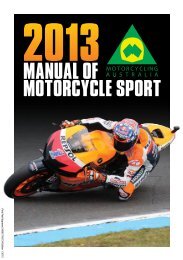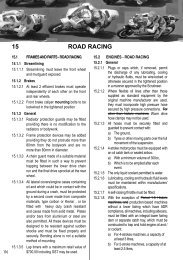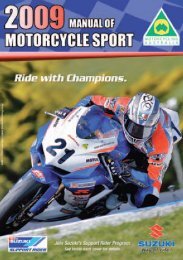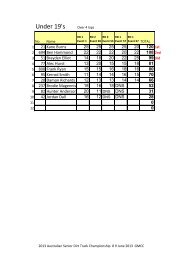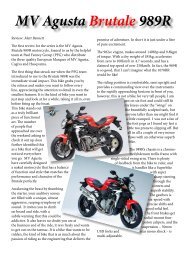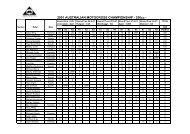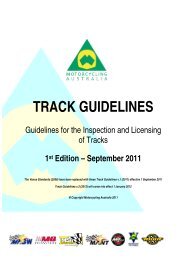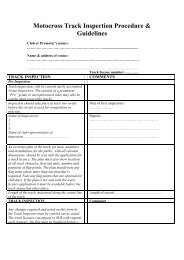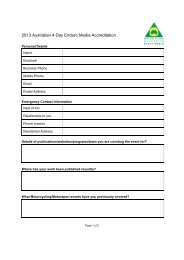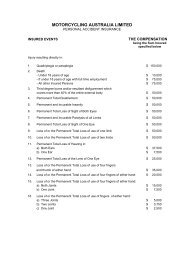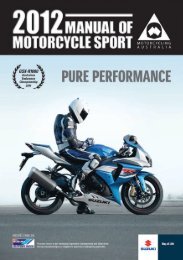2008 Manual of Motorcycle Sport - Motorcycling Australia
2008 Manual of Motorcycle Sport - Motorcycling Australia
2008 Manual of Motorcycle Sport - Motorcycling Australia
You also want an ePaper? Increase the reach of your titles
YUMPU automatically turns print PDFs into web optimized ePapers that Google loves.
This effort is to help you navigate as safely as<br />
possible, but there are always some hazards that<br />
appear during the event or may go unmarked, so<br />
you must beware.<br />
During an event, you may see trail markers,<br />
follow a roll chart or receive instructions from a<br />
corner person.<br />
Once on the road or trail, you must keep an eye<br />
out for trail markers, hazards and other road users.<br />
This can be very difficult for new riders whose focus<br />
might be on the trail in front <strong>of</strong> them, rather than<br />
their surroundings.<br />
At speed, it’s easy to miss a trail marker or misread<br />
the roll chart, so as you ride, remember to frequently<br />
look ahead for turns, obstacles and other road users.<br />
If you get hurt, stay close to the trail or road side<br />
so someone will see you. If you break down, stay<br />
with your bike. This protocol avoids arranging a<br />
search for people who may have left the trail.<br />
the corner man system<br />
MA events will <strong>of</strong>ten use an internationally<br />
recognised hazard system called the Corner Man<br />
(CM) system.<br />
The Corner Man System is a user-friendly<br />
system that helps create safer riding. It accounts<br />
for a variety <strong>of</strong> skills and experience, allowing<br />
everyone to ride at their own pace, with a safety net<br />
if something goes wrong.<br />
There are three main components <strong>of</strong> the CM<br />
System.<br />
Lead Rider – They wear red vests or helmet<br />
covers.<br />
Riders – known as the corner men.<br />
Sweeps – They wear green vests or helmet covers.<br />
how the corner man system works<br />
When the Lead Rider arrives at a hazard, an<br />
environmental issue or a change in trail direction,<br />
he/she will indicate to the following rider (using pre<br />
agreed hand signals) that they are to STOP and<br />
WAIT.<br />
That rider then becomes the Corner Man. Their<br />
job is to indicate to all riders that follow the hazard,<br />
or change in trail direction. They should also count<br />
the number <strong>of</strong> riders that pass, comparing it with the<br />
number that started.<br />
Only once the Sweep (last rider) arrives, the<br />
Corner Man can proceed. If there’s a difference in<br />
the number <strong>of</strong> riders that have passed the corner<br />
man and those who started, it’s the Corner Man’s<br />
enjoy the ride<br />
job to tell the Sweep(s).<br />
The benefit <strong>of</strong> the CM<br />
System is that it allows<br />
all riders to ride the trail at<br />
their own pace, determined<br />
by their experience. The<br />
more experience riders<br />
who have waited while<br />
acting as a Corner Man can<br />
make their way through the<br />
riding group. These riders may find themselves acting in<br />
the Corner Man role more frequently as their skill level<br />
dictates.<br />
No rider is permitted to pass the Lead Rider, and<br />
no rider should fall behind<br />
the Sweep.<br />
hand signals<br />
transport signal<br />
Once they receive a<br />
transport signal, riders<br />
must reduce their speed<br />
and not overtake. This<br />
signal may apply where<br />
there is a dust or other<br />
hazard.<br />
directional signal<br />
Riders need to follow<br />
the direction <strong>of</strong> the signal,<br />
coming from a Corner<br />
Man, and not ride on any<br />
sidetracks, major or minor, unless indicated.<br />
slow down<br />
When they receive the slow down signal, riders<br />
must reduce speed and watch, as there may be<br />
danger or hazard ahead. This signal may also be<br />
used where the trail can be easily damaged, so<br />
riders should keep a steady throttle.<br />
bike problems<br />
If a there’s problem with a bike, the rider should<br />
move it <strong>of</strong>f the trail to a safe area where it won’t<br />
obstruct other traffic. The following rider should stop<br />
to render assistance and aid in the investigation <strong>of</strong><br />
the problem. If it can’t be fixed, the Sweep(s) will<br />
follow the procedure for vehicle evacuation.<br />
If you become separated from the rest <strong>of</strong> group,<br />
stay calm and think carefully. Stop your bike, switch<br />
<strong>of</strong>f the engine and remove your helmet so you can<br />
hear other bikes. It might be some time before you<br />
<strong>2008</strong> RIDERS’ DIVISION MANUAL




